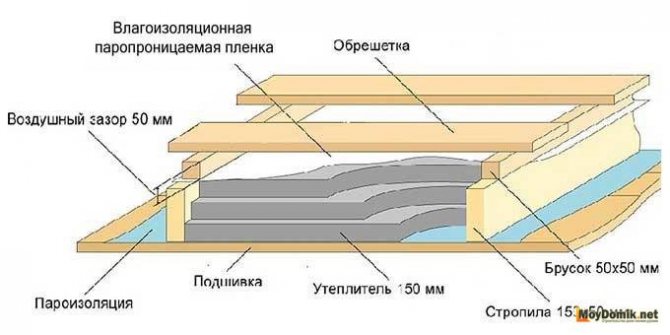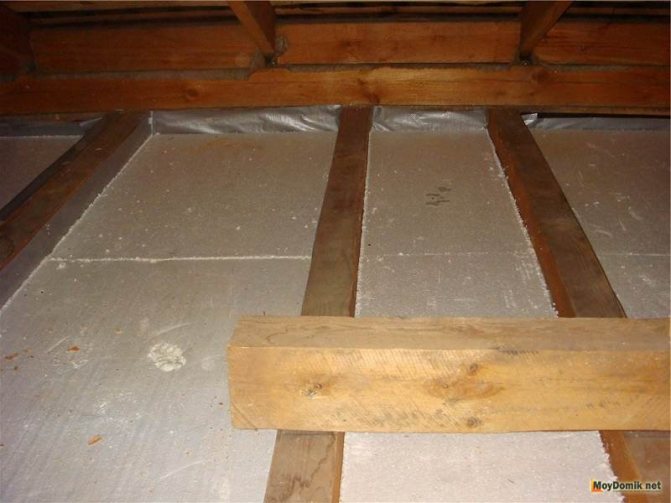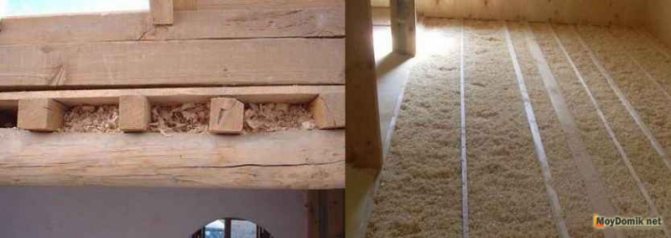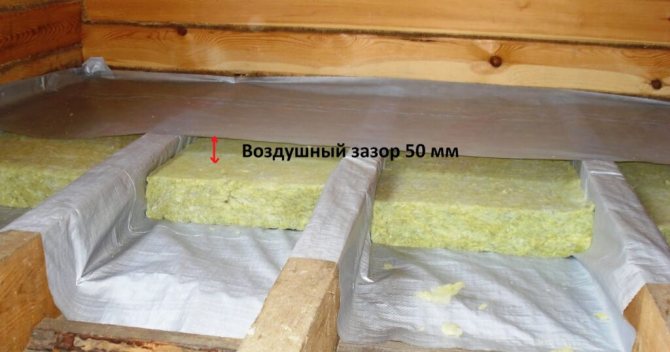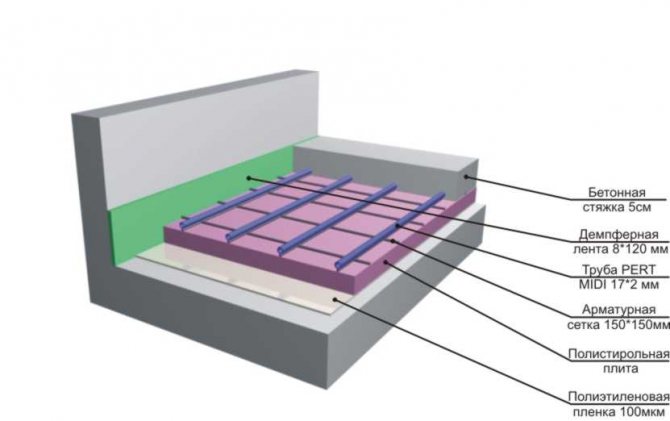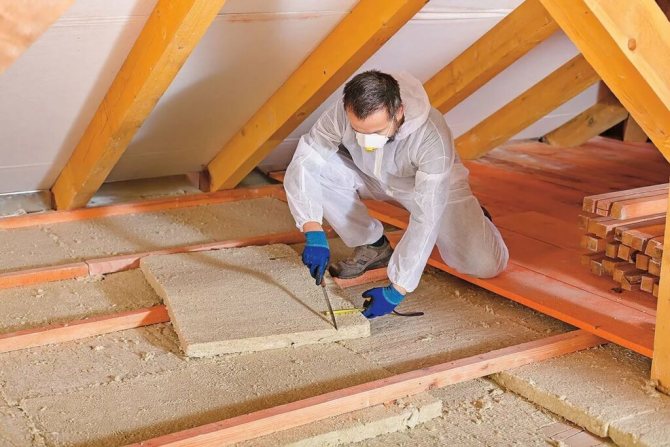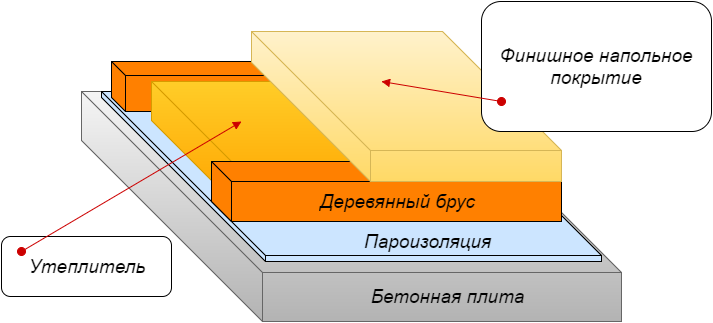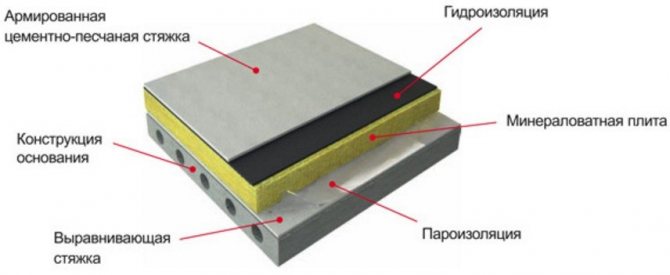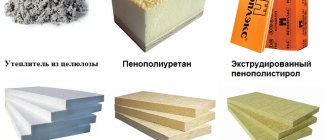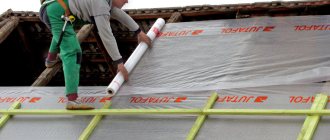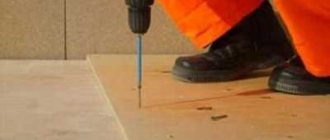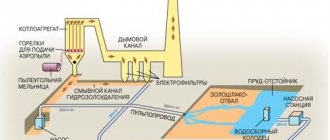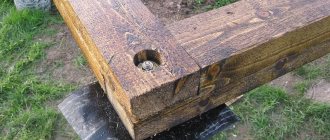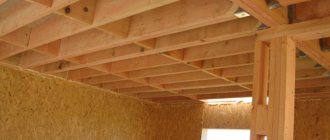Considerable attention is paid to insulation in construction. It is not an easy task to build a stable, durable and comfortable house for housing, a bathhouse, a storage room, but they will not be of any use if the issue of insulation is approached with carelessness and frivolity. After all, there is one situation when a person occasionally looks into such premises, but it is completely different when a person lives in them and spends a large amount of his time. This is especially true for frosty winter periods when insulation plays a fundamental role. Today we will figure out how best to approach the issue of warming the attic floor using wooden beams in a residential building, what material to use, and how to calculate everything correctly.
The process of warming the attic floor
When it comes to insulating a residential building, builders often neglect many of the most important criteria and points. So, for example, when insulating houses, the main attention is paid to insulating the floor and walls, which is correct, but after that many forget about the high-quality floor covering from above.
This is a gross mistake, because if we turn to the basic laws of physics, we will remember that warm air is always higher than cold air.
Obviously, with improper insulation, it will simply be ventilated into the attic, in fact, not fulfilling its main role. It follows from this that insulating the attic floor unit (in fact, the ceiling) is as important as other surfaces of the living space. The task is to insulate a wooden attic floor. You need to start with theory, namely, with the definition of the main criteria and features of a particular room, its characteristics and parameters.
What you should pay attention to when insulating the floor:
- On the specific features of the used floor material. If wooden beams are considered, then it is necessary to fully understand and sensibly evaluate its strength, durability and ability to withstand loads.
- On the ability to noise and moisture permeability of the material.
- Overlap construction.
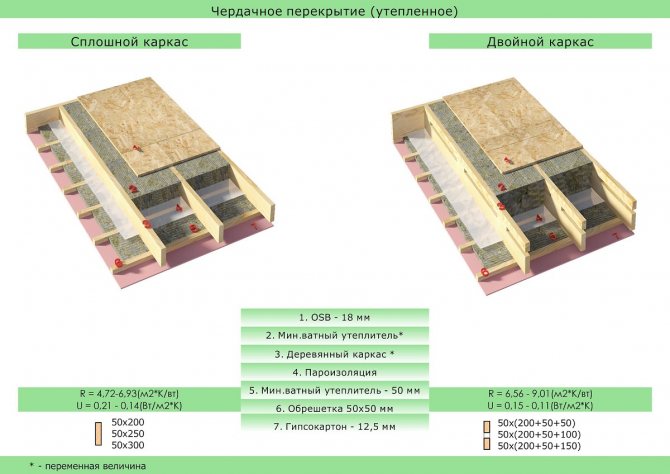
When planning the insulation of the attic, it is not only the hollow space in the beam floor itself that matters, but also the size of the beams themselves. So, on average, they are up to 40 cm in height, up to 15 m in length and up to 18-20 cm in width.
How to insulate the attic floor
To the question of how to insulate the attic floor, I will simply answer - with what is at hand, what can be easily bought and what can be bought cheap.
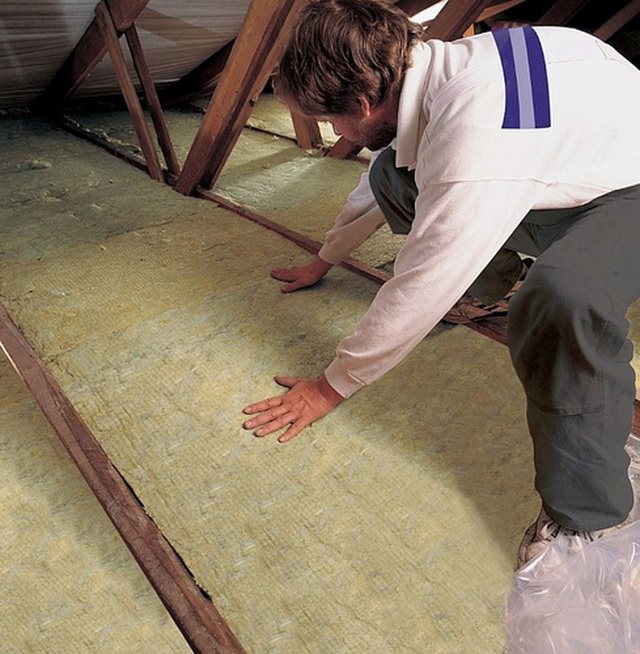

You can insulate the attic floor with basalt wool.
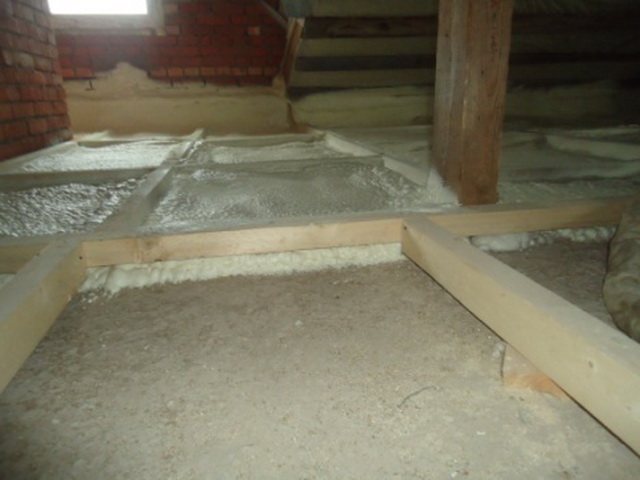

And you can blow out polyurethane foam between the overlap beams to insulate the attic.
It is better to insulate the attic floor with an excess amount of conditionally free lightweight insulation than an insufficient amount of expensive effective insulation.
You can insulate the attic with foam, basalt wool, rezol foam, foam glass, ecowool, polyurethane foam, adobe.
It is not at all necessary to insulate the attic with any heavy insulation, for example, clay with straw or other heavy hygroscopic material. This insulation shows itself quite well in the walls or in the attic of small buildings, such as a bath. But for the home, he poses a potential danger. It can become saturated with moisture and bring down the attic floor.
Why, for example, is it impossible to put clay and straw in the attic of the house, but expanded clay is possible? After all, it seems to be the same clay. Because expanded clay is expanded clay with cavities inside the granules.And even in a situation where expanded clay will be saturated with moisture, its weight will still remain much lower than the weight of the same layer of clay - straw insulation.
The choice of insulation for overlapping the attic
One of the main questions that arise for everyone who takes on the burden of insulating their attic is the question of which insulation to choose. After all, it is on this choice that the subsequent actions of a person, as well as the final result, will depend.
Among the most used and receiving positive reviews of materials, the following can be distinguished:
- Mineral wool. It has sufficient thermal insulation characteristics, but when choosing, be careful with the views. Mineral slag (slag wool) has the characteristics of steam accumulation, therefore, if we are talking about high-humidity rooms, check its properties when purchasing.
- One of the most common options is polystyrene. It is quite suitable for insulation, since it is practically incapable of accumulating moisture, and also copes well with sound insulation. However, some species are sensitive to severe temperatures and during frosty winter times, the duration of its operation can be reduced.
- Penoplex insulation. The best option for most cases, since in all respects it fully corresponds to the desired result. High density does not allow water to be absorbed, retains heat, is durable and has a long service life. It is also unfavorable for the reproduction of microorganisms and is resistant to biodegradation.
There is a method of spraying PPU (polyurethane foam). However, here it is worth considering all the features of this material. Thermal insulation depends on the number of layers applied, and sound insulation also correlates with the characteristics of its application and type.
Each selected insulation has its own characteristics and properties that should be taken into account.
However, it is more resistant to chemical and biological influences, almost does not absorb moisture. There is insulation with expanded clay, a layer of basalt and other materials for an individual case.
How to properly insulate an attic in a private house with your own hands
When building a private house with an attic room, you need to properly insulate it. Insulation of the attic floor in cold and unused rooms will prevent condensation from forming in the depths of the house.
There are several reasons why the attic floor is insulated:
- High-quality thermal insulation allows you to maintain a temperature in a residential building approximately corresponding to the dew point.
- Different temperatures at the junction of ceilings and walls lead to mold and harmful flora that contribute to the appearance of allergies.
Norms for insulation of attic reinforced concrete slabs
To produce high-quality insulation of the attic floor and extend the service life of the roof and rafters, you need to use a vapor barrier. It is worth knowing how to lay the vapor barrier correctly. The vapor barrier is laid on the slab, and on top there is already thermal insulation. This will prevent moisture build-up on the wood and metal parts of the attic space. In case of violation of the vapor barrier layer, as a result, the thermal insulation properties of the insulation deteriorate.
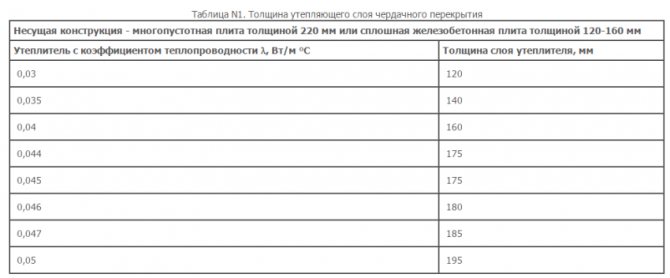

The thickness of the insulating layer of the attic floor
Frequently used insulation
Due to the high functional properties of mineral wool, it can insulate all surfaces, even uneven ones. Insulation is produced in rolls or soft plates. Preference is given to a material with a shielded heat-reflecting coating. You need to stack tightly, but without jams. This option has an optimal price / quality ratio. Good efficiency and durability at low cost. When installing insulation, you must use personal protective equipment. A protective material is laid on top of the cotton that does not allow steam and water to pass through. The floor insulation is overlapped and glued in order to avoid displacement.
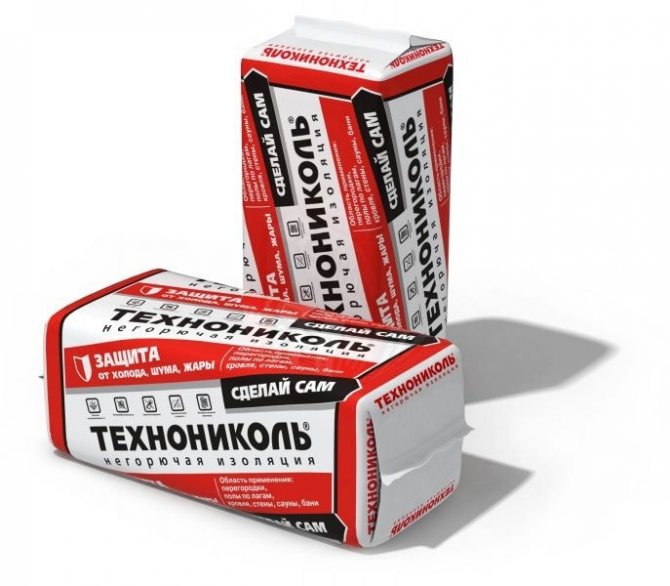

Insulation for the attic floor technoNIKOL
A more environmentally friendly insulation is stone wool. At the same time, having an excellent indicator of thermal conductivity for its class, it effectively smooths out temperature drops and maintains a comfortable microclimate.
How to insulate reinforced concrete slabs
To lay the insulation on the plates, a wooden beam is attached. Insulation in the form of loose material or overhead heat-insulating plates of different types is placed between the logs. Loose insulation is poured in a layer of 20 - 30 cm on the roofing material glued to the plates and poured with a not thick layer of mortar.
The most expensive and effective rigid insulation is foam glass. To obtain the desired effect from the use of foam concrete, the thickness of its laying layer should be about 0.4 m. No screed is required for it.


If you insulate with foam, then there is a large selection for price and performance. Low density foam is suitable for the attic.... Styrofoam plates are laid without the formation of cracks. If there are any gaps, then they should be filled with polyurethane foam. As for fire safety with this kind of insulation, in the event of exposure to high temperatures, melting occurs, and not fire. In this case, poisonous gas is released from the material, which is dangerous to humans.
The rule for any type of roll and tile insulation is that in order to avoid the formation of cracks in the insulated layer, it is necessary to observe a checkerboard pattern and correctly place the material in several layers.
The thickness of the insulation should be selected in accordance with the region where the private house is located, but not less than 15 cm.Saving by 5 cm and laying only 10 cm in a house with an attic is not worth it for the simple reason that the costs of insulation are one-time, but the effect of reducing heating costs will be noticeable over time.
Sources: https://opotolkax.com/montazh/uteplenie-potolka/uteplenie-cherdachnogo-perekrytiya-po-zhelezobetonnoj-plite.html https://strojdvor.ru/otoplenie/kak-pravilno-utevplit-cherdom -dome-s-xolodnoj-kryshej /
How to choose insulation for the attic floor
If sound insulation is not worried, but only the qualities of heat preservation are important, this is one option, and if everything in the complex is important and would like to do everything once and for all, forgetting about it for a long time, this is completely different.
What you need to take into account when choosing insulation for the ceiling:
- Directly the parameters of the material. The properties of some of them require additional attention and work, since they do not have all the necessary properties, or vice versa, they themselves create the need for them.
- Thermal insulation - its indicators.
- Soundproofing level.
- Water vapor permeability.
Also pay attention to the characteristics of the material. Most of them will require certain manipulations, such as, for example, an additional layer of vapor barrier underneath so that moisture does not linger and does not have a destructive effect on the wood.
Before buying a base for insulation, it is advisable to know the dimensions of the depressions in the overlap in order to accurately fall within the necessary framework.
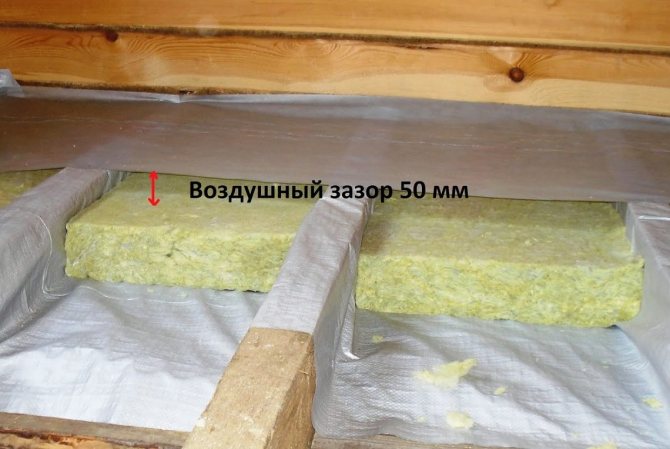

In order to understand exactly what the requests are, you can refer to the source of SNiP (Building Norms and Rules). Also, on top of the material itself, you will need to lay the level of the fastening base, or a thin screed, including for the purpose of additional heat and vapor barrier.
Mineral wool applications
Mineral wool is an effective insulation, the fibers in which are arranged in a special way. Due to this randomness, an oxygen "cushion" is formed between the fibers, due to which the material acquires its properties. But because of the same feature, mineral wool or and absorbs moisture. In order to prevent this, the installation must be carried out properly.
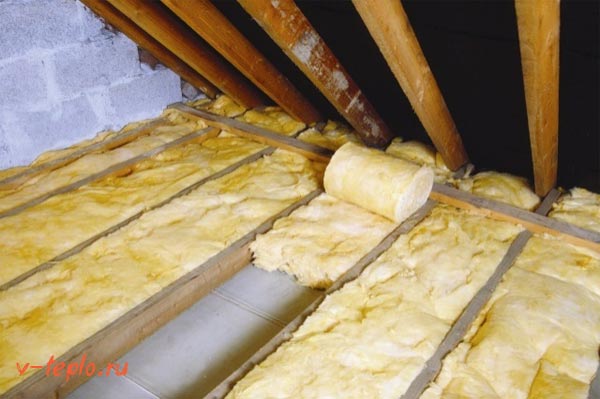

The advantages of this material are undeniable:
- density;
- ease of installation;
- long service life;
- fire safety;
- finally, if the cotton wool is installed horizontally, then it does not slip and does not cake (read: cold bridges do not appear).
But there is also a drawback that we talked about - it absorbs moisture.
Installation technology
Mineral wool can be laid in three possible ways:
The first method is the most effective. The laying technology itself is as follows.
Step 1. First, lay the vapor barrier material - this is necessary to remove the steam that rises from the premises. For proper installation, it is necessary to familiarize yourself with the markings on the film made by the manufacturer.
Note! Do not forget to observe the mandatory overlap of 10 centimeters.
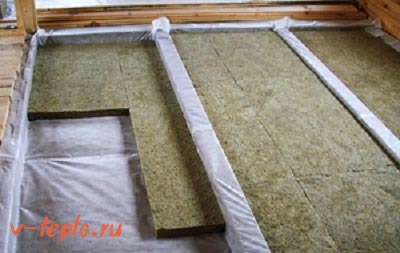

If the thermal insulation is done along the beams, then the vapor barrier must bend around each element that protrudes, otherwise the beams will soon rot.
Step 2. Where the film meets walls and other surfaces that protrude, raise it to the height of the insulating material + 5 centimeters, then wrap it over the slabs of material or glue it with tape.
Step 3. After that, proceed with the installation of the insulating material. This procedure is extremely simple, since strips and slabs can be easily cut with a construction knife.
Step 4. When laying, pay attention to the fact that the insulation is not squeezed and there are no gaps. You can see the common mistakes in the image below.
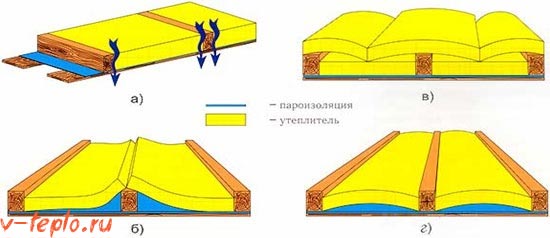

/ p>
In the first case, the thickness of the thermal insulation is not enough, in the rest, the same parameter of the attic floor is incorrectly selected.
Good advice on mineral wool insulation
- Foil-coated material will increase the resistance to heat loss. But the material itself should be laid down with foil.
- If there are protruding structural elements in the attic, then the insulation should be raised by 40-50 centimeters and fixed.
- If a thin insulation material is laid in two layers, then it will be more effective than one thick layer.
- Do not allow material to protrude from the beams. But if this still happened, lengthen it by means of a rail or beam to the thickness of the material itself.
Step 5. If the rafter system is not protected by a waterproofing layer, and the attic will not be used, then it is necessary to install waterproofing.
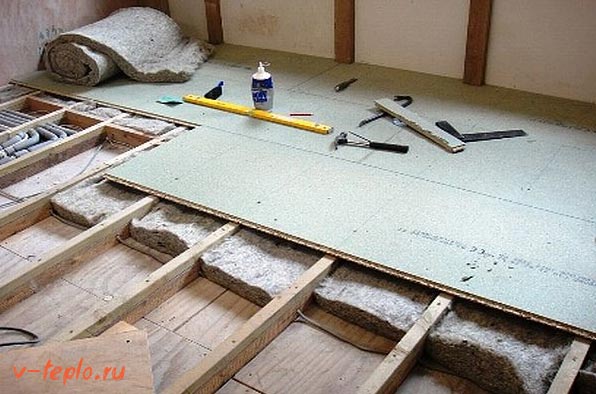

Step 6. It remains only to make a rough floor. To do this, lay it on a heater - this will be the basis for the final finish.
How to insulate the attic floor
So, having chosen the optimal warm material and having acquired everything you need, it's time to take on a simple but painstaking job (in most cases). It should be noted that depending on the choice of the resource, the installation will become more complicated or simpler as it is done.
Insulation of the attic floor:
- Initially, you should calculate all the parameters (if you did not do it at the time of purchase) - the width, length and height of the floor.
- If the length and thickness are a matter of chance, then the height correlates with several factors, which is why many experts give different indications on this score. Optimally - 250 mm in height, so that the insulation rises slightly above the beams.
- Install an additional bottom layer of steam insulation (if necessary).
Depending on the material chosen, place it in the space between the timber beams and fit tightly. If you use spraying, do it to a solid structure of the formed plaque. Again, if you chose this option - make a surface coating, or start laying the screed.
Competent insulation of the attic floor on wooden beams (video)
Pay particular attention to the mineral wool, or rather to its swelling properties in contact with water.To eliminate such consequences, it is better to provide it with a moisture-insulating film. Approach the issue of construction with due attention and excluding frivolity. Do not forget about ceiling insulation.
Comments (1)
0 Daniel 27.01.2018 07:29 When I equipped the attic, I did not have such knowledge and I simply insulated the attic with foam plastic, without air gaps, it was my mistake, but as it is, if this information turned up to me at that time, I did everything would be as it should. Competent information.
Quote
Refresh comment list RSS feed of comments for this post
